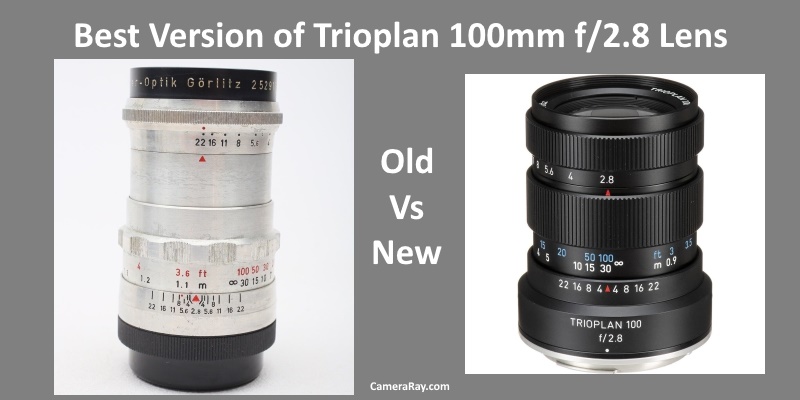
Best Version of Trioplan 100mm f2.8 Lens: Old or the New One.
The world of photography offers a plethora of choices when it comes to equipment, with lenses arguably being the most vital component of a photographer’s arsenal. One particular lens that has left its mark in the industry is the Trioplan 100mm f/2.8. Manufactured by Meyer-Optik Gorlitz, a German optics company, the Trioplan 100mm f/2.8 lens has been renowned for its ‘soap bubble’ bokeh and sharp center, characteristics that have been maintained across different versions of the lens. Let’s delve into an in-depth comparison to determine which version stands out among the rest.
Firstly, it’s essential to acknowledge the original Trioplan 100mm f/2.8 lens. Launched in the early 20th century, it brought an innovative approach to photography with its unique ‘soap bubble’ bokeh. The lens featured a triplet design, simple yet capable of rendering images with a distinctive, artistic character. The original Trioplan was beautifully crafted, using brass and aluminum materials that ensured durability and a timeless aesthetic. However, due to the old coating technologies and lack of modern features like autofocus, the vintage model might seem less appealing to contemporary photographers.
In 2016, Meyer Optik Gorlitz launched a Kickstarter campaign to reintroduce the Trioplan 100mm f/2.8 lens with modern updates, appealing to nostalgic photographers and those looking for artistic effect in their work. This version retained the unique triplet design and soap bubble bokeh while featuring improved coatings, reducing flare and increasing contrast. The 2016 model also brought a new, robust metal housing and a 15-blade diaphragm for smoother bokeh. However, it still lacked modern conveniences such as autofocus, and some users noted that the lens was difficult to focus accurately due to a thin depth of field.
The third and the most recent version of the Trioplan 100mm f/2.8 lens arrived in 2020, an iteration that seems to have found the perfect balance between old-world charm and modern technology. A redesigned lens housing gave this version a more contemporary look, and improved the ease of handling with a smoother, more precise manual focusing ring. The updated version incorporated advanced lens coating technologies, further enhancing image quality and providing superior contrast and color rendering. Despite these improvements, this version remained true to its roots, preserving the classic soap bubble bokeh effect that photographers have come to love.
So, among these three, which version of the Trioplan 100mm f/2.8 lens is the best? It truly depends on what you, as a photographer, value most.
If you are a vintage enthusiast or a purist who appreciates originality, the classic charm of the original Trioplan 100mm f/2.8 might be the best choice. Its simple construction and unique rendering offer a different, nostalgic photographic experience. However, you should be prepared for potential issues related to older optical and mechanical designs.
The 2016 version of the Trioplan 100mm f/2.8 would suit those who want a taste of the lens’s historical characteristics while enjoying improved image quality, due to better lens coatings. Nevertheless, this model still demands a high level of manual control from the photographer, with its entirely manual operation.
For most photographers, especially those who appreciate a mix of modernity and vintage charm, the 2020 version seems to be the best option. It retains the iconic soap bubble bokeh effect, provides an improved focusing experience, and delivers high-quality images with excellent contrast and colors due to advanced lens coatings. It’s a great fusion of old and new, with the charm of a vintage lens and the refinements expected in modern optics. It offers the best of both worlds, making photography both a nostalgic and technologically advanced experience.
Also, the 2020 model is built with a modern housing that is robust yet easy to handle, even in challenging conditions. This contemporary model ensures more durability and reliability while ensuring the lens fits comfortably in modern photography kits. The precise focusing ring on this model makes manual focusing a much more pleasing process, even with the inherently thin depth of field.
However, it is important to remember that the 2020 version, like its predecessors, lacks autofocus. For photographers who rely heavily on this feature, this might be a limitation. But for those who embrace the more thoughtful, deliberate approach that manual focusing necessitates, this lens can serve as a tool for enhancing creativity and refining photographic skills.
Lastly, let’s consider the pricing. The original vintage Trioplan 100mm f/2.8 can occasionally be found on the used market at relatively reasonable prices, considering its historical value. However, these lenses often show signs of wear and might require servicing. The 2016 version, though less frequently available, usually comes at a higher price due to its improved features and fewer years in use. The 2020 version, being the most recent, is the most expensive. However, it arguably offers the best value considering its enhancements in usability, image quality, and build.
In conclusion, while each version of the Trioplan 100mm f/2.8 has its unique charm and strengths, the 2020 model stands out for its combination of vintage aesthetics and modern advancements. It’s the best option for photographers looking to capture unique images without compromising the practicality and image quality afforded by modern lens technology. Nevertheless, whichever version you choose, the Trioplan 100mm f/2.8 promises a unique and enchanting photographic experience.